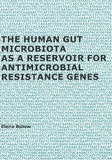The human gut microbiota as a reservoir for antimicrobial resistance genes
Summary
In the last decades, the emergence and spread of resistant opportunistic pathogens is compromising the effectiveness of antimicrobial therapies. Understanding the emergence and global spread of drug-resistant microorganisms is thus crucial to combat antimicrobial resistance. The human gut harbors a densely populated and highly diverse microbial ecosystem – the gut microbiota – that can serve as a reservoir for antibiotic resistance genes (‘the resistome’) and for drug-resistant opportunistic pathogens. Critically ill patients that are hospitalized in Intensive Care Units (ICUs) are particularly susceptible to nosocomial infections caused by bacteria that are members of the normal human microbiota. In order to prevent or treat nosocomial infections in these patients, antibiotic therapy is frequently used in patients that are hospitalized in ICUs. Other antimicrobial agents than antibiotics, such as disinfectants, are also important in limiting the prevalence of pathogenic microorganisms and nosocomial infections in clinical settings. However, their effectiveness is similarly compromised by the emergence of pathogens with reduced susceptibility to disinfectants. Previous studies have shown that the gut microbiota is significantly impacted by antimicrobial therapy. Yet, the dynamics of the gut resistome during such therapies and its contribution to the emergence and dissemination of antimicrobial resistance remain poorly understood. In this thesis the dynamics of the gut microbiota and resistome of adult hospitalized patients in an ICU receiving prophylactic and curative antibiotic therapies were investigated using culture-independent techniques. Because gut-associated bacteria and their resistance genes may be shed into the environment through sewage, we also assessed the levels of antibiotic resistance genes in hospital sewage and in subsequent stages of wastewater treatment. The gut microbiota as a putative reservoir for disinfectant resistance genes is also studied. This thesis provides novel insights into the dynamics and diversity of the gut microbiota and the resistome of hospitalized patients, and highlights the significant effects of ICU hospitalization on the gut resistome and microbiota. The expansion of the gut resistome during ICU hospitalization and antimicrobial therapies shown here is a cause for concern. Follow up investigations combining gut microbiology and resistome studies may be be performed to assess the potential transfer of these resistance genes to nosocomial pathogens during and after hospitalization.
